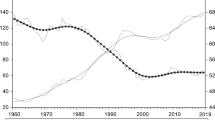Abstract
Garnishment of wage as a way for creditors to enforce payment by unwilling or insolvent debtors, while very common in Germany and Switzerland, is not very successful. Based on a dynamic model of debtor behaviour, this paper explores two alternatives of reform. One is to reduce the rate of garnishment, which at present amounts to 100 percent of the wage income exceeding a defined subsistence level, thus probably destroying incentives to work. According to model simulations, reducing the rate of garnishment is likely to result in an increase of labour supply but a decrease of garnishment revenue per period. Second, the introduction of a debt release as it exists in the United States would have an ambiguous effect on labour supply. While providing debtors with a fresh start, it would result a partial loss for creditors. A Pareto improvement thus does not seem to be possible. When taxpayers as an involved third party are taken into account, however, a potential Pareto improvement appears attainable through debt release.
Similar content being viewed by others
References
Amonn. (1997). Grundriss des Schuldbetreibungs-und Konkursrechts [Overview of the Swiss Bankruptcy Law], 6th ed., Bern.
Andreoni, J. (1991). “The Desirability of a Permanent Tax Amnesty.” Journal of Public Economics. 45, 143-159.
Bundesamt für Statistik [Ed.]. (1992). Verbrauchserhebung 1990: Ausgaben und Einnahmen der privaten Haushalte [Consumption Survey 1990: Expenditures and Incomes of Private Households], Reihe 6: Produktion, Bern: Handel und Verbrauch.
Bundesamt für Statistik [Ed.]. (1998). Statistisches Jahrbuch 1998 [Statistical Yearbook 1998], Zurich: Verlag Neue Zürcher Zeitung.
Bundesverband Deutscher Inkasso-Unternehmen e.V. (1997). “Inkasso-Branche und Gerichtsvollzieher fordern Entlastung der Justiz” [“Debt Collecting Agencies and Bailiffs Ask for Relief of Judiciary”], Mitteilungen für die Presse, November 17.
Chiang, A. C. (1992). Elements of Dynamic Optimization, New York: McGraw-Hill.
Das-Gupta, A. (1996). “Tax Amnesties as Asset-Laundering Devices.” Journal of Law, Economics and Organisation. 12(2), 408-431.
Dubey, A., and Shubik, M. (1988). “A Note on an Optimal Garnishing Rule.” Economics Letters. 27, 5-6.
Dutta, P. K. (1994). “Bankruptcy and Expected Utility Maximization.” Journal of Economic Dynamics and Control. 18, 539-560.
Favre, A. (1989). Praktischer Ratgeber für das Schuldbetreibungs-und Konkursrecht mit Verzeichnis der schweizerischen Betreibungs-und Konkursämter [A Guide through the Swiss Bankruptcy Law], Echallens.
Fehr, E., Kirchsteiger, G., and Riedl, A. (1996). “Involuntary Unemployment and Non-Compensating Wage Differentials in an Experimental Labour Market.” Economic Journal. 106, 106-121.
Forsblad, K. (1997). Restschuldbefreiung und Verbraucherinsolvenz im künftigen deutschen Insolvenzrecht [Debt Release and Insolvency of Private Households in the Future German Bankruptcy Law], Frankfurt: Peter Lang.
Gropp, R., Scholz, J. K., and White, M. J. (1997). “Personal Bankruptcy and Credit Supply and Demand.” Quarterly Journal of Economics. February, 217-251.
Meier, I., Zweifel, P., Zaborowski, C., and Jent-Sørensen, I. (1999).” Auf der Suche nach dem optimalen Existenziminimum” [“In Search of an Optimal Subsistence Level”] Project-Forthcoming report for the Swiss Science Foundation, project no. 12-45487.95, Schulthess-Verlag, Zürich.
Landesarbeitsamt Nordrhein-Westfalen/Landesarbeitsamt Baden-Württemberg. (1996). Zur Überschuldung von Arbeitslosen [Indebtedness of the Unemployed], Düsseldorf.
Lea, S. E. G., Webley, P., and Levine, R. M. (1993). “The Economic Psychology of Consumer Debt.” Journal of Economic Psychology. 14, 85-119.
Lea, S. E. G., Webley, P., and Walker, C. M. (1995). “Psychological Factors in Consumer Debt: Money Management, Economic Socialization, and Credit Use.” Journal of Economic Psychology. 16, 681-701.
Leu, R. E., Burri, S., and Priester, T. (1997). Lebensqualität und Armut in der Schweiz [Quality of Life and Poverty in Switzerland], Bern: Verlag Paul Haupt.
Phelps, E. S., Hoon, H. T., Kanaginis, G., and Zoega, G. (1994). Structural Slumps: The Modern Equilibrium Theory of Unemployment, Interest, and Assets, Cambridge, MA: Harvard University Press.
Rosendorfer, T. (1993). Schuldensituation und Haushaltsführung überschuldeter Haushalte: Eine empirische Unersuchung ausgewählter Haushalte in München [The Situation of Indebted Households: An Empirical Analysis of Households in Munich], Frankfurt an Main: Verlag Peter Lang.
Sethi, S. P. et al. (1997). Optimal Consumption and Investment with Bankruptcy, Boston: Kluwer Academic Publishers.
Sullivan, T. A., Warren, E., and Westbrook, J. L. (1989). As we Forgive our Debtors: Bankruptcy and Consumer Credit in America, New York: Oxford University Press.
Sullivan, T. A., Warran, E., and Westbrook, J. L. (1994). “A Financial Comparison of Consumer Bankrupts 1981–1991.” American Bankruptcy Law Journal. 68, 121-154.
Spühler, Stücheli, und Pfister. (1996). Schuldbetreibungs-und Konkursrecht I [Bankruptcy Law I], Zürich: Lecture Notes.
Spühler, Pfister. (1997). Schuldbetreibungs-und Konkursrecht II [Bankruptcy Law II], Zürich.
Stiglitz, J. E. (1984). “Theories of Wage Rigidity,” NBER Working Paper 1442.
Tokunaga, H. (1993). “The Use and Abuse of Consumer Credit: Application of Psychological Theory and Research.” Journal of Economic Psychology. 14, 285-316.
Walder, J. S. (1990). Tafeln zum Schuldbetreibungs-und Konkursrecht [Bankruptcy Law in Tabular Form], 4th ed., Zürich.
Zaborowski, C. (1999). “Gründe und Folgen der Zahlungsunfähigkeit und Überschuldung privater Haushalte in der Schweiz: Ein wirtschaftstheoretischer Ansatz” [“Causes and Consequences of Insolvency and Indebtedness of Private Households in Switzerland: An Approach by Economic Theory”], Dissertation, University of Zurich.
Author information
Authors and Affiliations
Rights and permissions
About this article
Cite this article
Zaborowski, C., Zweifel, P. Getting Out of Debt: Garnishment of Wage in Whose Interest?. European Journal of Law and Economics 8, 207–230 (1999). https://doi.org/10.1023/A:1008795309844
Issue Date:
DOI: https://doi.org/10.1023/A:1008795309844




